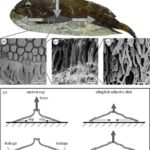Clingfish biology inspires better suction cup
A team of engineers and marine biologists built a better suction cup inspired by the mechanism that allows the clingfish to adhere to both smooth and rough surfaces. Researchers reverse engineered the clingfish’s suction disk and developed devices that cling well to wet and dry objects both in an out of water. The devices can hold up to hundreds of times their own weight. The secret mimicking the attachment mechanism that the animal uses was to incorporate a soft layer and slits in the artificial suction cups. The clingfish’s suction disc is lined with rows of hexagonal structures, called papillae, which are covered with microscopic fibers. Researchers mimicked this inside their prototypes with a soft layer made out of silicone.
Related posts:
Learn about our two Decals!
 Click here to find out more about our Fall Bioinspired Design Decal and our Spring Bioinspired Design in Action Decal – ALL MAJORS are welcome.
Click here to find out more about our Fall Bioinspired Design Decal and our Spring Bioinspired Design in Action Decal – ALL MAJORS are welcome.Berkeley BioDesign Community
 Click here to learn about the BioD: Bio-Inspired Design @ Berkeley student organization or here to signup for more info.
Click here to learn about the BioD: Bio-Inspired Design @ Berkeley student organization or here to signup for more info.Search
Student Login




I imagine that the neurological circuits underlying these processes are governed by both 2d spacing maps with their brains as…
to reduce the impact of car accidents, it may be possible to study the force diverting physics of cockroaches to…
you see this type of head-bobbing stability in many avian creatures related to pigeons like chickens. the head ability to…
not like they taught horses how to run! this is an example of convergent evolution where both sea creatures and…
The brain functions in a similar way with neuronal connections. our brains are able to utilize the multiplicity of connections…